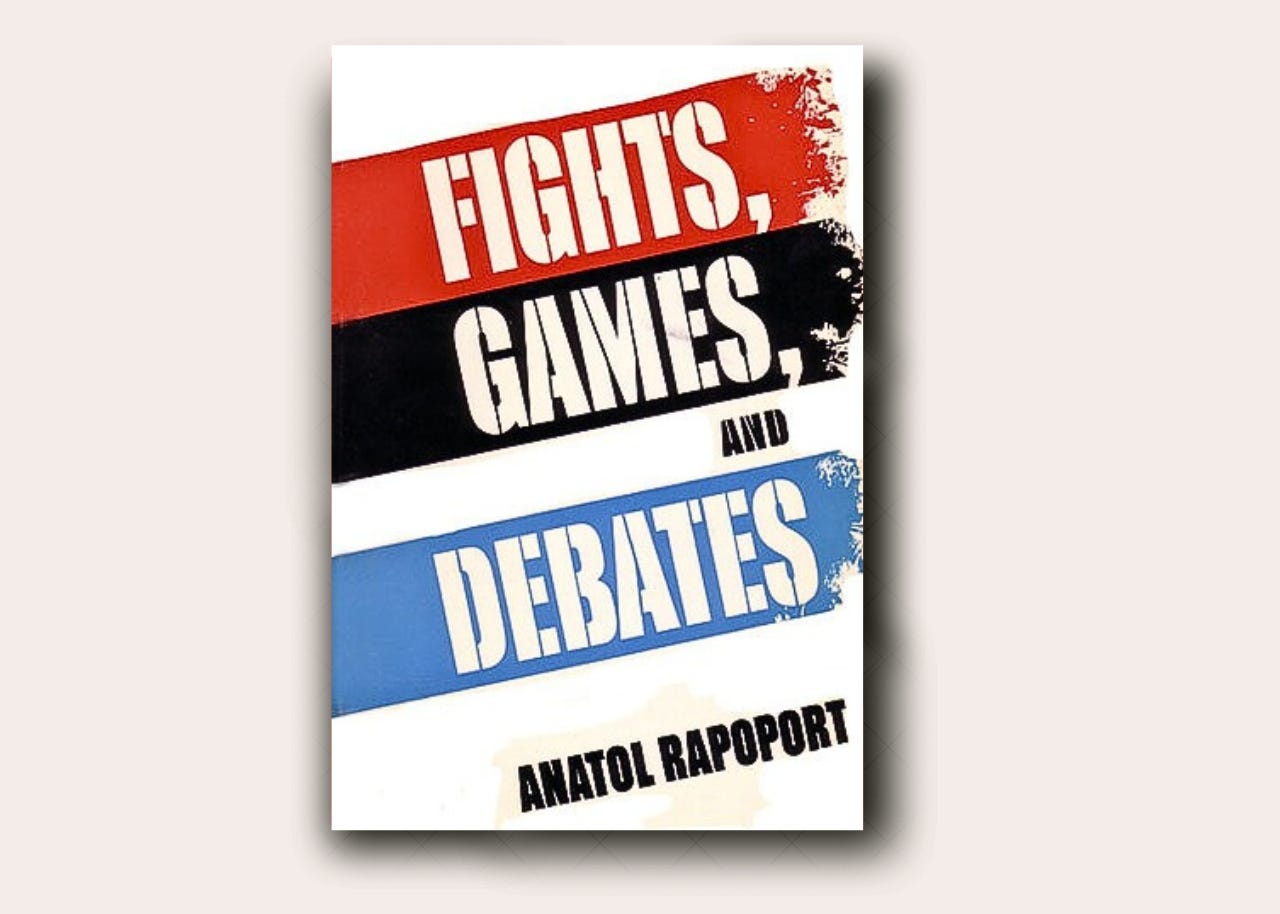How to discuss any topic without yelling or wanting to kill anyone: The Rapoport Protocol
Distilling Books - Number 12
Welcome to Mental Garden. The following letter is part of our “Distilling Books” collection, in which we extract the most revealing ideas from literature. For the complete library, click here.
🏷️ Categories: Decision making and biases, Social relationships.
We’ve all been in conversations that ended in shouting matches.
It all started with a “I was just saying…” and ended with a door slamming shut, an awkward silence, or worse, a broken relationship. It’s the story of every badly handled argument. Words turn into weapons, arguments into trenches, and suddenly you’re more interested in “winning” than in understanding.
Sadly, this is the most common outcome.
If you’ve ever tried to have a difficult conversation and it went wrong, today I’ll share a technique that will change everything. It’s called the Rapoport Protocol, from the book Fights, Games and Debates by Anatol Rapoport, a Russian-American psychologist. His protocol has been used in Cold War negotiations, political debates that seemed impossible, and even in hostage negotiations.
That’s how effective it is.
You’ll learn how to discuss any topic without yelling, without hurting, and with positive results.
1. Explain the other person’s position clearly
To discuss a topic, you first need to understand each other’s positions.
Start by explaining your own stance on the topic in detail. Do it as clearly and simply as possible to make sure the other person understands you. Then, they must explain your point of view in their own words.
They should understand you well enough that you can say: “Exactly, that’s what I mean.”
Imagine you disagree with someone about the Israeli–Palestinian conflict. Before sharing your opinion, you should be able to perfectly explain the other person’s point of view. Former FBI negotiator Chris Voss also recommends doing this (Fridman, 2017). This way, no one feels attacked.
When someone feels understood, their guard goes down.
You stop feeling attacked and start feeling heard. Everything shifts.
2. Mention something valuable you’ve learned
While listening to each other’s positions, jot down points of interest, facts you didn’t know, or anything that made you think. Then, each person shares those notes—what they found valuable or insightful.
It doesn’t have to be huge, but this simple step changes the tone of the discussion.
When we feel this trust, our brain releases oxytocin, making us more collaborative (Zak, 2018). It’s pure chemistry.
3. List the points you agree on
Most debates turn into trench wars because we forget everything we do agree on. We focus so much on the 10% difference that we ignore the 90% connection.
Make a list of all the points discussed and mark the ones you share.
By saying “we agree on this, this, and this,” you lower the tension and remind the other person that you’re on the same team. That the disagreement isn’t personal. That you want the negotiation to be good for both.
And now, finally, comes the critique…
4. Offer your critique
Only after listening, noting key points, and finding common ground can you offer criticism.
But now you’ll do it from a completely different place. It won’t be the usual kind of critique. At this point, the other person will feel calmer, more open to your words, and your critique—without any extra effort—will be much more effective. It won’t feel like a declaration of war.
It will feel like a friendly negotiation.
If you do it right, even if you don’t reach an agreement, both of you will leave satisfied with the outcome. And that’s a small miracle in a world where everyone wants to be right and crush the other side without listening.
Real change starts when you listen.
You don’t need to be a communication expert.
You just need to apply the protocol—to negotiate intelligently, not by shouting.
✍️ Your turn: How could you apply the Rapoport Protocol to those thorny, uncomfortable topics you’ve been avoiding?
💭 Quote of the day: “One must take into account the potential and evaluate alternative outcomes if one wants to understand the adversaries’ reactions to each other’s moves.” — Anatol Rapoport, Fights, Games, and Debates (1960)
See you in the next letter! 👋






There’s decades old, well established and researched processes for each of these steps for eg:
1. Active listening by Carl Rogers
2. Appreciative enquiry
3. Non violent communication
4. Influence without authority
Good article. I listed all your points so I can remember them. Thank you. Also, restacking to Notes. Some of the people on Notes urge people to vilify and ignore the other side, identifying them as evil and their cases without merit. Not exactly a unifying mentality. I hope many will read this and reconsider their stands.